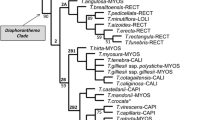Conclusions
From the above, it can be seen that, although with only limited data, a study of general occurrence of alkaloids seems to indicate certain correlation with phylogeny. Within the dicotyledons, there is a high incidence of alkaloid occurrence in the morphologically primitive Magnoliales–Ranales complex and related groups, a lower incidence in various phylogenetically intermediate groups and a progression of high incidence in all of the phylogenetically advanced but unrelated groups. Notably, the generally wind–pollinated “amentiferous” families, as well as the wholly aquatic families, are either alkaloid–absent or show very low incidence.
High incidence of alkaloid occurrence appears as a general character, for some families or orders. In some families, such as Ranunculaceae, Berberidaceae, Menispermaceae, Piperaceae, Cactaceae, Papaveraceae, and Gentianaceae, alkaloids occur in over 90% of the species tested. In many others, there is also a high, though less pronounced, percentage. On the other hand, in certain families such as Fagaceae, Betulacae, Casuarinaceae, and Juglandaceae the alkaloid occurrence is almost zero. Thus, the occurrence of alkaloids can be treated as a general family characteristic. At the ordinal level, high or low incidence may appear uniformly in all component families of a single order or sometimes pronouncedly in one of the component families. As a general characteristic, incidence of alkaloid occurrence appears to be a useful one for phylogenetic analysis at the family or order levels.
Even though, with the limited amount of data available, it is futile to speculate on the significance of alkaloid incidence among the dicotyledons (other than to point out the seemingly definite pattern of correlation with the phylogenetic scale), it may be worthwhile to point out the notable absence or near absence of alkaloids among the “amentiferous” families (which are windpollinated). Further research along the lines correlating pollination and specific pollinators with distribution and structure of alkaloids, together with the morphology, taxonomy and phylogeny of the flowering plants, will be most desirable and may yield interesting results.
Similar content being viewed by others
Literature Cited
Alston, E. E., and B. L. Turner. Biochemical systematics. Englewood Cliffs, N. J. 1963.
Engler, A. Syllabus der Pflanzenfamilien. Vol. 2. (12th ed., revised by H. Melchior). Berlin. 1964.
Gundersen, A. Families of dicotyledons. Waltham, Mass. 1950.
Hegnauer, E. The taxonomie significance of alkaloids.In: Swain, T. (ed.) Chemical plant taxonomy, pp. 382-427. New York. 1963.
---. Chemotaxonomie der Pflanzen. Basel. Vol. I, 1962, Vol. II, 1963.
Hutchinson, J. Families of flowering plants. London. Vol. I, Dicotyledons, 1st ed. 1926; 2nd ed. 1950. Vol. 2, Monocotyledons, 1st ed. 1934; 2nd ed. 1950.
Lawrence, G. H. M. Taxonomy of vascular plants. New York. 1951.
Manske, R. H. F. Sources of alkaloids and their isolation.In: Manske, R. H. F., and H. L. Holmes (eds.). The alkaloids: chemistry and physiology, pp. 1–14. New York. 1950.
McNair, J. B. Plant forms, the law of mass action and the production of alkaloids, cyanogenetic and organic sulfur compounds. Amer. Jour. Bot.28: 179–184. 1941.
— Some comparisons of chemical ontogeny with chemical phylogeny in vascular plants. Lloydia8: 145–169. 1945.
Robinson, T. The organic constituents of higher plants: their chemistry and interrelationships. Minneapolis. 1963.
Willaman, J. J., and B. G. Schubert. Alkaloid–bearing plants and their contained alkaloids. U.S.D.A., A.R.S. Tech. Bull.1234. 1961.
— and H. L. Li. General relationships among plants and their alkaloids. Econ. Bot.17: 180–185. 1963.
Author information
Authors and Affiliations
Rights and permissions
About this article
Cite this article
Li, H.L., Willaman, J.J. Distribution of alkaloids in angiosperm phytogeny. Econ Bot 22, 239–252 (1968). https://doi.org/10.1007/BF02861957
Received:
Issue Date:
DOI: https://doi.org/10.1007/BF02861957




